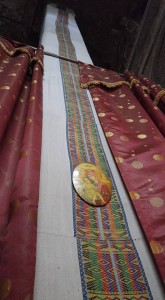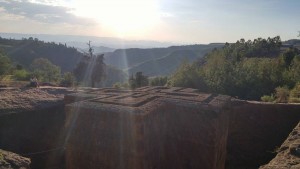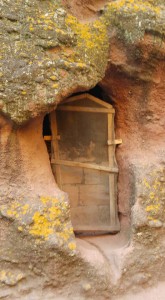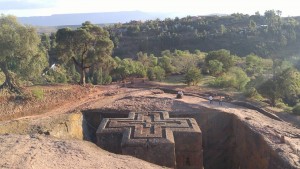I arrived in Lalibela in high spirits, yet sick from the past few days. I had just spent a frigid night’s sleep in a tent high in the Simien Mountains without a proper sleeping bag, but that’s another story. I was a little tired, but more than anything, weary of the lies and tricks that I had learned were commonly employed by unscrupulous touts to separate travelers from their money. Sometimes, it seems, when things get a little extreme the pendulum begins to swing the other way.
As soon as I set foot in my hotel I was already being pressured to buy a tour package. Following some hard-ball negotiations with this new middleman, I was able to secure a guide and vehicle for two days of touring Lalibela’s wealth of historic sites. Little did they know that after all I’d been through I had hardened into a professional haggler. The tout I spoke with named his price in Ethiopian birr and I countered with half of what he asked, and then barely budged. I ended up booking the tour for $35 less than his first price. So it goes when traveling alone in Africa, day in and day out. You can always tell when a traveler has been in Africa for an extended period of time when you see one of them haggling with an older woman on the street over a bushel of bananas. In a last ditch attempt to save more money, I struck a deal with a mother and daughter traveling pair from New Zealand who were waiting at the ticket booth of the park’s entrance. I arranged for them to join my tour and split the expense with me, and then had to convince the guide not to charge them an exorbitant additional amount to cover “increased taxes and fees.”
After we got started it became clear that our guide was exceptional. The tour turned out to be a great value after all. The guide had his work cut out for him. Lalibela speaks for itself. Its structures jutted unexpectedly from the ground like an ancient civilization rising from the dead. Each building was a massive monolith carved in reverse; from ground level down to bedrock. As we approached from the entrance all that was visible were the tops of the churches protruding slightly above ground level. In order to accomplish such a miraculous feat of engineering it is widely believed that a labor force of roughly 30,000 slaves was employed alongside trained elephants used as beasts of burden. Together they excavated millions of tons of stone and dirt to create a peripheral pit as deep as the hundred foot structures are tall. From there the builders would flesh out the interior by creating a window and entering through the top, excavating as they went
Considering that little more than chisels were used for this process, one would expect the buildings to be of crude construction. To the contrary, the design was executed with stunning architectural precision. Complex geometric shapes that were engraved in stone in the 12th century were built to such exacting specifications that you can take a tape measure to them and find perfect symmetry. Not to mention that they are created from singular pieces of solid stone connected entirely to the surrounding rock. The churches of Lalibela are not only a UNESCO World Heritage Site, but are also considered by many to be the unofficial eighth wonder of the world. Due in part to its remote location, the site receives a paltry 40,000 visitors a year including domestic tourists. By contrast, one of the women in my tour group works for a museum in New Zealand whose travelling whale exhibit can receive as many as 500,000 visitors in a matter of months at some locations.
In the U.S. only about 30% of Americans even own a passport. The only way I can make sense of this is through the expression that ‘ignorance is bliss’. If more people knew what was out there waiting to be explored and discovered and experienced there would be no way to keep them home. While there are many people who think that travel is too expensive or out of their reach, if they could see what I saw at Lalibela alone they would be selling their plasma if it meant getting a taste of it.
At the entrance to each looming church we removed our shoes and waited as our guide said a silent prayer. He is a devout Christian, as he proudly proclaimed right off the bat. Being able to escort tourists around the holy sites was a form of religious expression for him, not so different from being a preacher. He already came across to me as earnest, and I took his belief in a greater obligation as a sign that his work was guaranteed, in much the same way as I would prefer hiring a bonded tradesman.
On the other hand, while I was impressed with his work ethic, certain statements led me to question the reliability of his information. For example, when a member of the group asked how long it took King Lalibela to finish all of these literally massive rock-hewn churches he responded in all seriousness that since angels had aided in the construction, the entire thing had been finished in less than 30 years. His estimate is an interesting testament to the dichotomous impact his beliefs have had on him.
So much had been revealed in a short time through simple, straightforward conversation. While there is something mysterious about a civilization such as the Zagwe Empire engineering advanced and uniquely constructed monuments out of the blue, all of the scientific and archaeological evidence indicates that there’s no way it could have been completed during the King’s lifetime. Not only does my tour guide’s belief in the miraculous nature of the churches glaringly conflict with the science, but one look at the site by the untrained eye would be enough to convince any non-believer that his assertion is implausible at best.
One of the many marvels of Lalibela is the vibrant living history. After hundreds of years the ruins are still home to droves of monks and priests. They hold regular services in the sites’ ancient churches in much the same way as their people have for nearly a millennium. Although tourists can be seen wandering about and sometimes even take pictures of the monks, this unbroken tradition is still as authentic as it gets. With a relatively small number of visitors, many of whom are Christian pilgrims, there isn’t the sensation that the locals are donning costumes or putting on a show to prop up the local economy as is sometimes the case in more heavily touristed sites.
Between my guide’s beyond-professional devotion and the time warped monks chanting in their ancestral Ge’ez language in doorframes and under chiseled archways, it was a glimpse of a history which is truly alive and well. By observing the site’s ongoing use I got a tangible reminder of how the region’s history continues to effect the present day. It’s an impression that I’ll never forget. Seeing the rock-hewn monoliths reach out of the earth was to me symbolic of the power of the past. The undeniable impact of our shared heritage on the present day. King Lalibela literally cast stones whose influence has reverberated through time. Like concentric ripples spreading outward, news of his accomplishments have spread to the shores of modern America and beckoned me across the world with their enchanting allure. Not even the skyscrapers that crown the New York City skyline, the ultimate monument to American capitalism, will endure as long as this one man’s expression of his faith.
Such insight comes from the drive to see such things for yourself. I pondered the staggering beauty of these marvels that had been crafted in the name of God. A seemingly impossible design conceived as an act of devotion and inspired by the Divine. As an outsider with only the most cursory understanding of the Ethiopian Orthodox faith, it struck me that if ever there was a place to ponder the impact of religion on culture and history it was that place. I explored each tunnel, pondered every catacomb and chamber with a sense of awe not at all diminished from that of the first Westerners to ever lay eyes on it. While touring the sites I noticed that there appeared to be some contradiction to the effects of religion on my guide’s thought processes. While he indicated with pride in many small ways that his faith provides him with a moral compass, with integrity, and with guiding values, other statements seemed to indicate that he is willing to ignore certain truths that contradict his religious beliefs.

Covering for the sacred Tabot, an artifact representing the Ark of the Covenant. There is one inside of every Ethiopian Orthodox Church, and these historic sites are no exception
As my attention shifted focus between the guide’s words and the structures he was referencing, I couldn’t help but feel that the cultural attitudes that he expressed ran parallel to values espoused so long ago by the architects in the shadow of whose creation we were standing. In my opinion one of the greatest legacies of the world’s religions is the wealth of artistic expression so often created in its name. Yet there is another side to this gift upon humanity, a side that my guide seemed intent on glossing over. I cannot bring myself to take the leap of faith in believing that while King Lalibela worked by day, the angels worked by night to craft the structures in miraculously few years, however pleasant the thought may be. I can’t overlook that whatever morality spurred on this grand innovation also condoned the use of around 30,000 slaves and brutal abuse of the region’s elephants, none of whom continue to roam wild anywhere near Lalibela. Death by forced labor was so common that many of the catacombs that we breezed past on the way to each temple without the slightest acknowledgment were dug as unmarked mass graves for the workers that didn’t make it. With the hearts and minds of so many modern Ethiopians still as affected by Orthodox religion as they were in the 12th century, the impact of religion on the Ethiopian culture is as clear as an equatorial day.
Attaining this kind of understanding was a self-induced process derived from a mix of factors. I had the drive to seek this sort of thing out and see it in person, even if it meant facing a myriad of trials and challenges to reach such a remote area. I could only fully appreciate it as an outsider. The same frustrations that I had with the language barrier and undecipherable alphabet were also what allowed me to get the most from my experience. Also, travelling alone was a plus. It afforded me a greater degree of immersion in the culture than if I had the buffer of traveling companions. Lastly, I paid as much attention to the people I met along the way as the history that surrounded me. The result was a profound convergence of culture and history that I am still processing, and will likely continue to process throughout my life.









